There is nothing better to satisfy your pizza cravings than this hearty gluten-free Chicago-style deep dish pizza! This truly authentic recipe features a rich and buttery crust, filled to the brim with a generous amount of gooey cheese and a chunky tomato sauce.
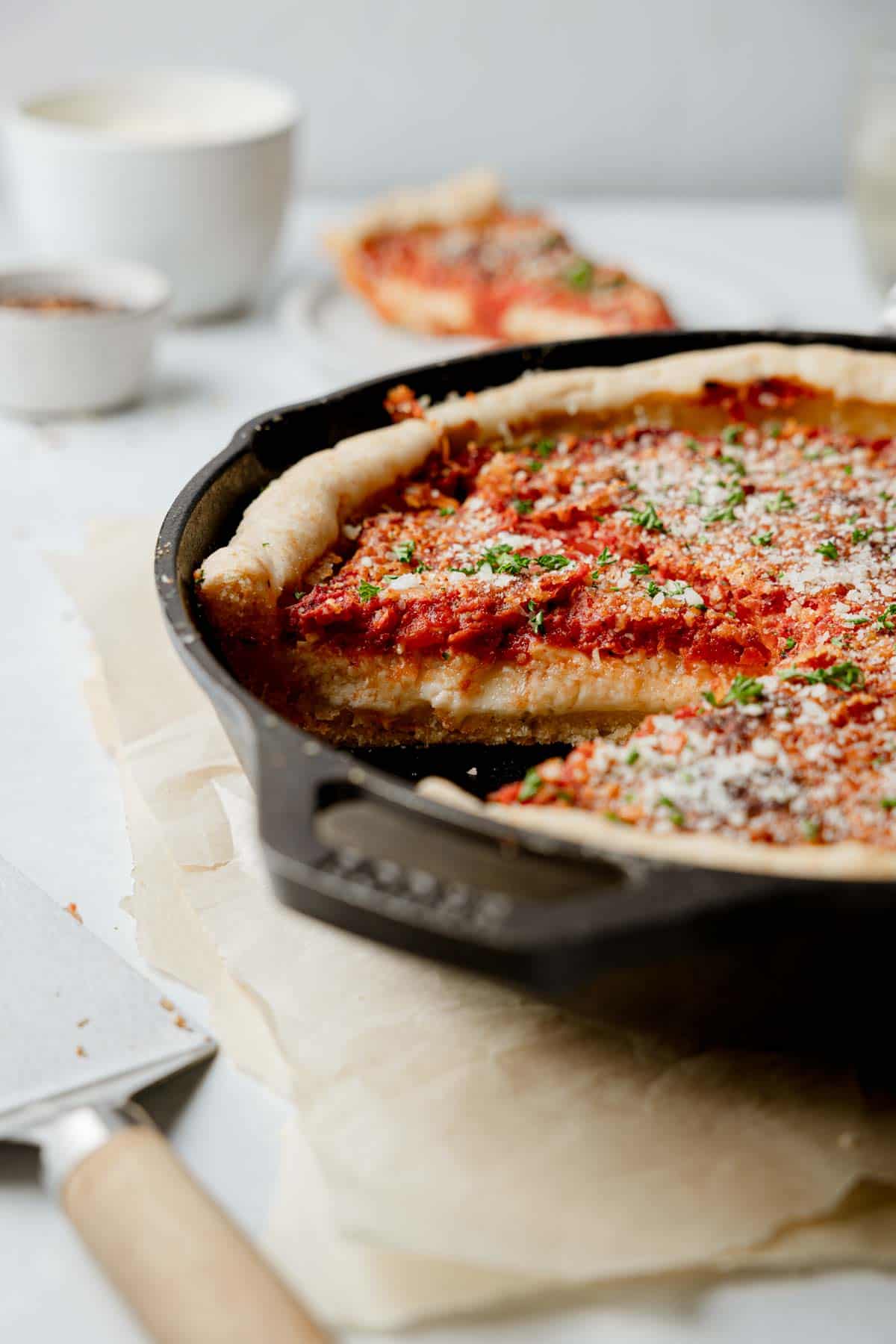
💌 Want to Save This?
Unsubsribe at any time.
Jump to:
- Why This Is The Best Recipe!
- What defines Chicago-Style Deep Dish Pizza?
- Caputo Fioreglut
- History of Chicago Deep Dish
- Traditional Deep Dish Toppings
- Gluten-Free Pizza Dough Ingredients
- Deep Dish Sauce and Filling Ingredients
- Equipment Needed
- How to Make the Dough
- Let It Chill!
- How to Make the Sauce
- Waste not!
- Assembling a Deep Dish Pizza
- What about toppings?
- How to Tell When Deep Dish Pizza is Done
- How to Serve Deep Dish Pizza
- Storage
- What to Serve with Deep Dish Pizza
- More Recipe Tips
- FAQ
- More Recipes You'll Love
- Join My Newsletter!
- Still Hungry? Subscribe Here!
- Recipe
- Comments and Ratings
Why This Is The Best Recipe!
Pizza is still one of those things I miss with this gluten-free life. And while I've made an excellent gluten-free pizza crust before, there are so many variations on pizza, I would love to replicate them all!
This gluten-free deep dish pizza recipe definitely hits the mark, especially if you're craving truly authentic Chicago-style deep dish pizza, which if you know, is quite different than pan pizza and should not be confused with gluten-free Detroit-style pizza either!
Growing up right here in the heart of Illinois, I've been spoiled with good pizza pretty much my entire life. (That is until I was diagnosed with celiac disease.) The fact that we have the best pizza isn't just a myth either, when locals move away, you're sure to hear them lament that they miss good pizza!
Maybe what makes it so great is the variety. While Chicago may be known for deep dish style pizza, there are actually quite a few legendary styles of pizza here, like square cut tavern-style pizza, stuffed pizza, quad-city style thin crust, or the pizza pot pie just to name a few!
All this good pizza makes me somewhat of a pizza snob, so you can trust me when I say, this gluten-free recipe is not only a darn good take on the Chicago deep dish, it may just be the best deep dish pizza on the internet!
Also, be sure to check out my gluten-free egg noodles recipe, it gets rave reviews and makes the best gluten-free pasta!
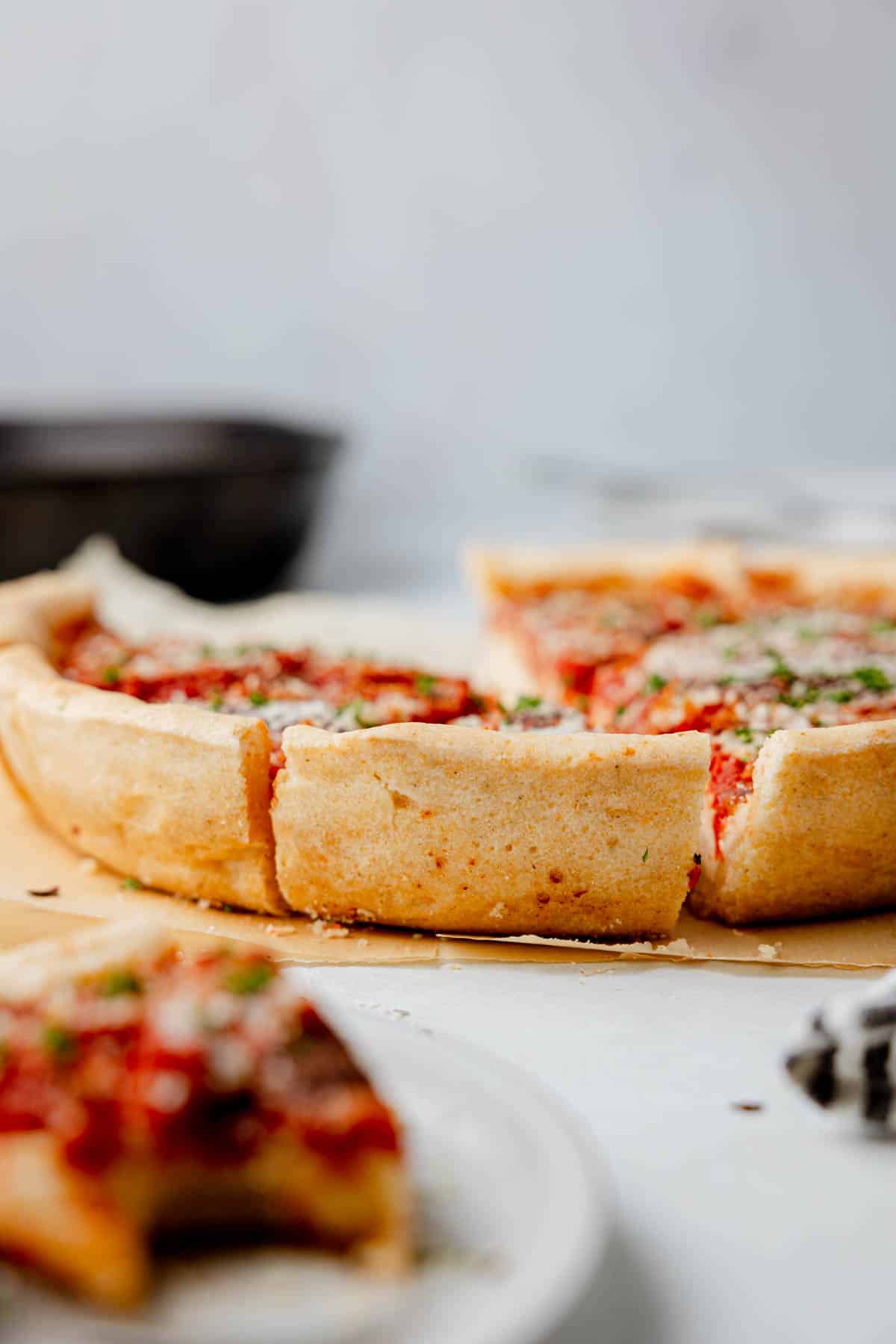
What defines Chicago-Style Deep Dish Pizza?
A true Chicago-style deep dish has very specific characteristics:
- Chicago deep dish pizza does not have a pillowy soft or thick crust, actually it's quite the opposite! This style of pizza is made with a thin, crisp, and buttery, high-sided crust that can handle plenty of fillings.
- Chicago pizza is also made in a very specific way. It is assembled with the crust on the bottom, followed by cheese, your favorite toppings, and lastly a chunky tomato sauce on top.
- The sauce on the top serves a very specific purpose, it allows the pizza to cook all the way through without the top getting burnt. If the cheese or toppings were on top, they would brown to perfection well before the rest of the pizza were finished.
- The deep round pan allows for the perfect balance of crust, cheese, toppings, and sauce. In true midwest fashion, some consider this style of pizza the casserole of pizzas, especially since it's usually so hearty you need a knife and fork to eat it!

Get the Goods!
Caputo Fioreglut
I recommend you buy Caputo Fioreglut from Brick Oven Baker. They have great prices and you can use code: KATIE for 10% off your first order!
History of Chicago Deep Dish
Chicago deep dish pizza has a rich history with several contenders claiming credit for the invention of a 'pizza thick as a sewer lid and almost as heavy'. One popular narrative attributes it to Ike Sewell and Ric Riccardo, who opened Pizzeria Uno in 1943. However, evidence supporting their actual role in the invention of this iconic pizza is limited, mostly because no one had ever seen them actually make the pizzas.
Rather, Adolpho "Rudy" Malnati, Sr. and Alice May Redmond, who were both associated with Uno's at the time, are believed to have played a significant role in perfecting the deep dish pizza recipe. Although no one knows for sure who made it first.
It was also around this time that Rudy's son, Lou, began working with his father and eventually became a co-manager of Pizzeria Uno in the 1950s. Then in 1971, Lou and his wife Jean opened up the first Lou Malnati's Pizzeria, now one of the most well-beloved restaurants for Chicago deep dish pizza.
Gino's East, another Chicago landmark, was founded in 1966 by Sam Levine and Fred Bartoli. They employed the aforementioned Alice May Redmond and her sister Ruth Hadley, who developed a special dough recipe that made Gino's East famous.
While the exact origins of Chicago's deep dish remain unclear, it's undeniable that these individuals have shaped Chicago's deep dish pizza into the iconic and beloved dish it is today.
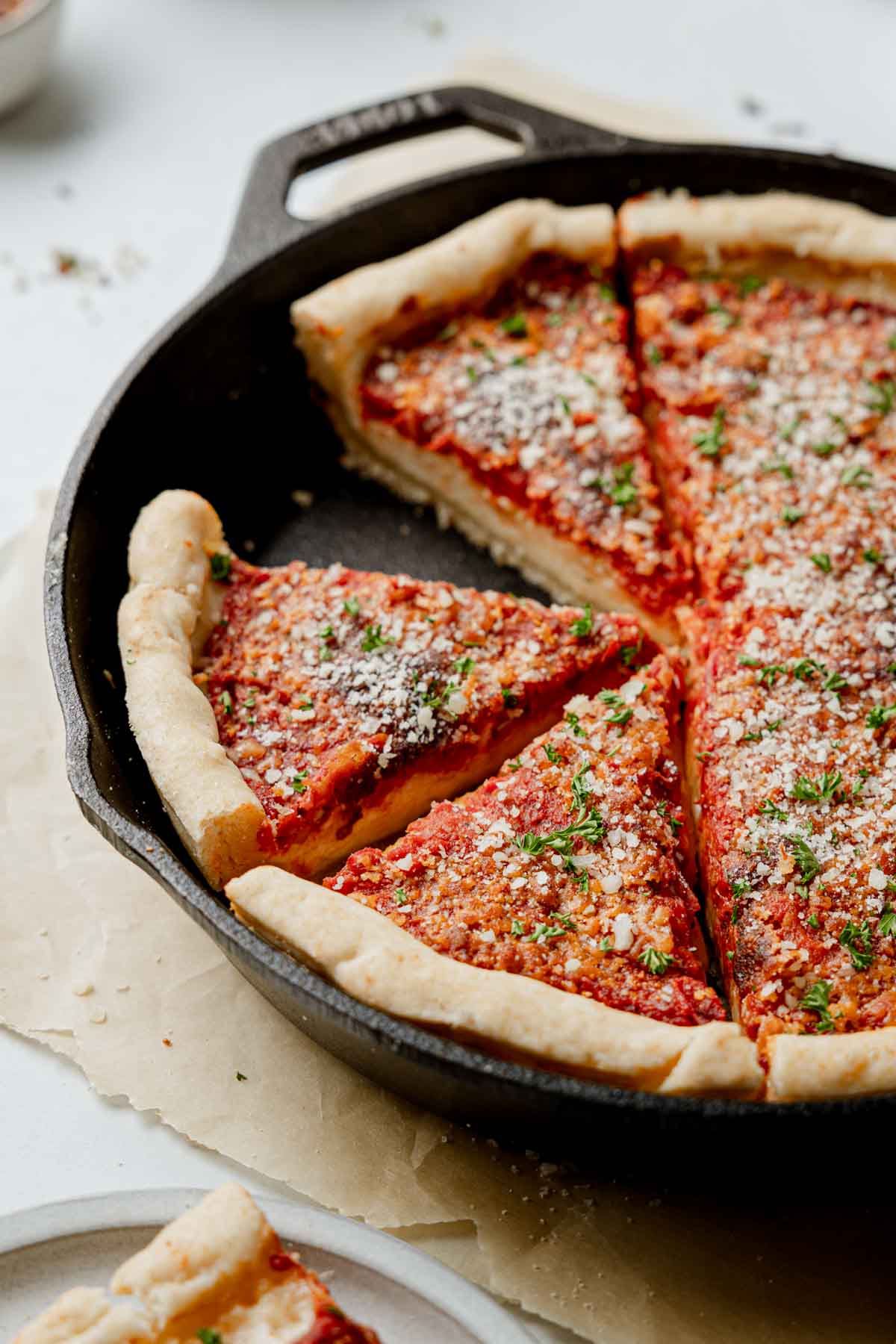
Traditional Deep Dish Toppings
If you really want to be authentic, these toppings will pass the test. While it's all relative as far as "good" pizza toppings go, these are the most traditional toppings that truly stand the test of time.
- Plain cheese: This pizza is very satisfying, even if it's only filled with cheese!
- Italian Sausage: Not sausage links, rather bulk Italian sausage. This is arguably the most traditional deep dish pizza topping. Use high quality Italian sausage, which has a flavorful blend of Italian spices, especially fennel.
- Supreme: A traditional combination of toppings here in Illinois is sausage, pepperoni, onions, green bell peppers, mushrooms, and sometimes black olives. You'll find this combination listed right on the menu at most pizzerias.
- Pepperoni: Pepperoni slices are a classic pizza topping most everyone loves and are a great topping for your deep dish pizza.
Gluten-Free Pizza Dough Ingredients
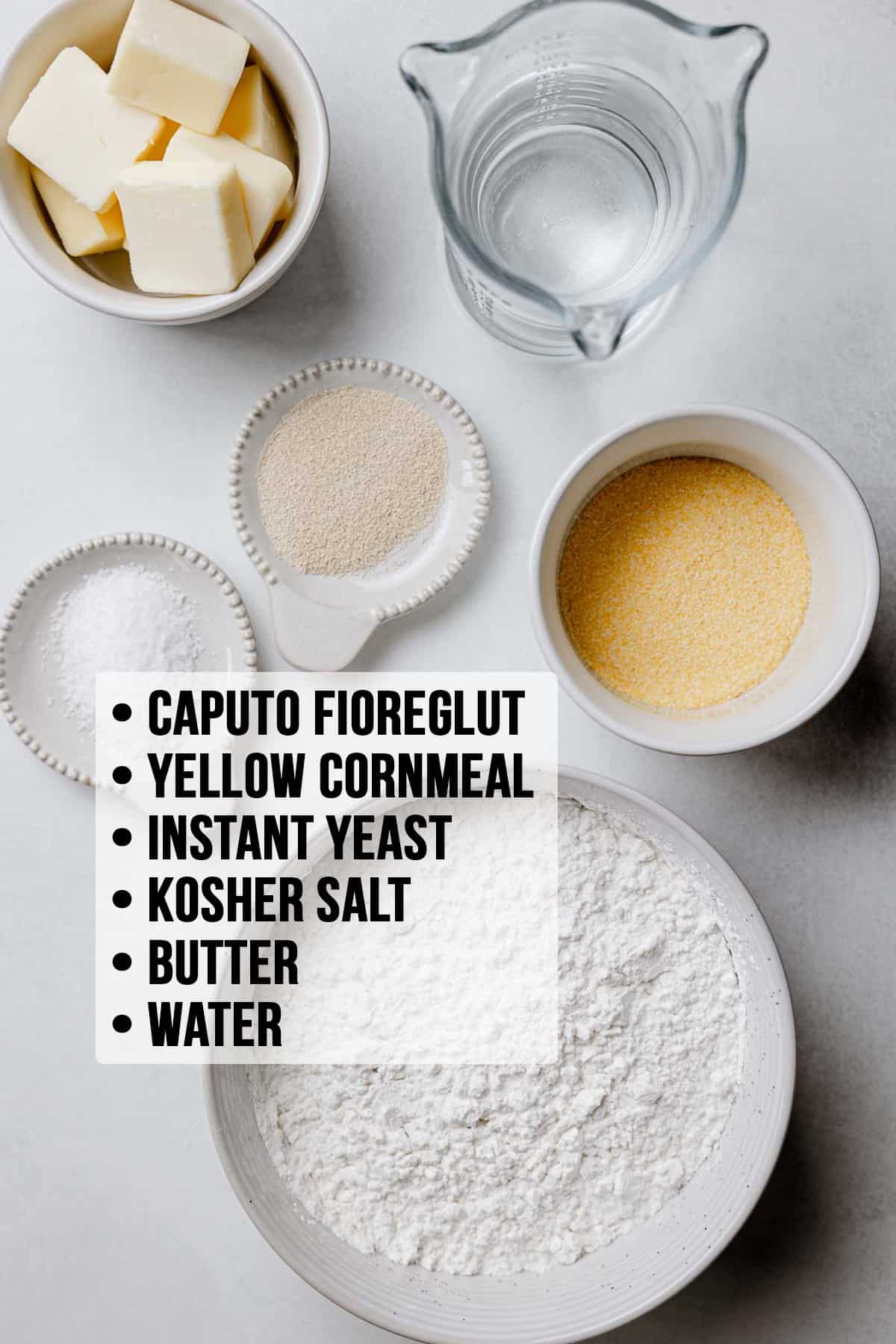
- Caputo Fioreglut Gluten-Free Flour Blend: This is the only flour recommended for this recipe. Please note: it does contain gluten-free wheat starch and is not suitable for those with a wheat allergy. I have not tested this, but Cup4Cup may be a suitable substitute.
- Yellow Cornmeal I've tried to determine if this is truly an authentic addition to the dough, and it may not actually be, but I do appreciate the flavor and texture the cornmeal provides in this pizza.
- Instant Yeast or Rapid Rise Yeast: This type of yeast is highly active, fast-rising yeast is the easiest to use, especially for gluten-free baking! You can mix the yeast right in with the dry ingredients without dissolving in water first. If you only have active dry yeast, be sure to dissolve it first in the warm milk for five minutes before adding it to the rest of the recipe.
- Kosher Salt
- Butter: Part of what sets true Chicago-style pizza apart from other deep dish pizzas, which call for olive oil, is that there's butter in the crust. Butter adds a rich flavor and flakiness to the crust.
Deep Dish Sauce and Filling Ingredients
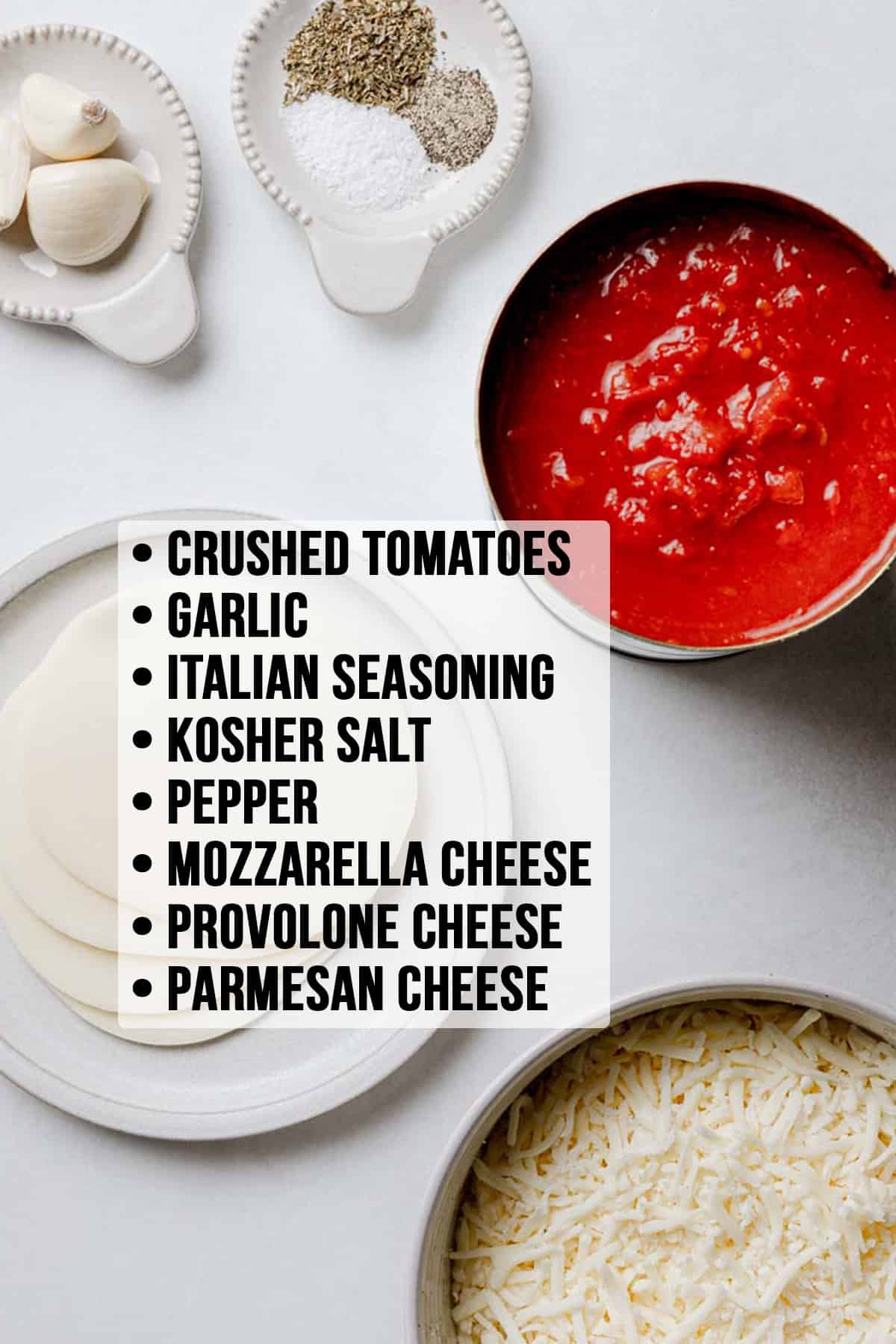
- Crushed Tomatoes: Be sure to use good quality crushed tomatoes. The better the tomato, the more delicious the sauce will be! If you can find San Marzano crushed tomatoes, that's the best option. Here are a few brands I like:
- Garlic
- Italian Seasoning
- Mozzarella Cheese: Freshly grated is always best, but pre-shredded cheese is gluten-free and works just fine as well.
- Provolone Cheese: Either grated or sliced.
- Parmesan Cheese: Grated parmesan is more authentic, rather than shredded.
- Your favorite pizza toppings: Such as Italian sausage, pepperoni, onions, mushrooms, and/or peppers.
Equipment Needed
Aside from the ingredients above, you'll need some equipment to make this recipe.
- A digital kitchen scale is highly recommended, especially for measuring the dough ingredients. This is the best way to get accurate measurements.
- A KitchenAid Stand Mixer makes mixing the dough much easier.
- A 10-inch Cast Iron Skillet or deep dish pizza pan is essential for this pizza. A properly sized cake pan or springform pan will also work.
- A fine mesh strainer is needed to make the simple tomato sauce.
- A rolling pin for rolling out the dough.
How to Make the Dough
If you can measure ingredients and turn on a mixer, you can make this gluten-free deep dish dough.
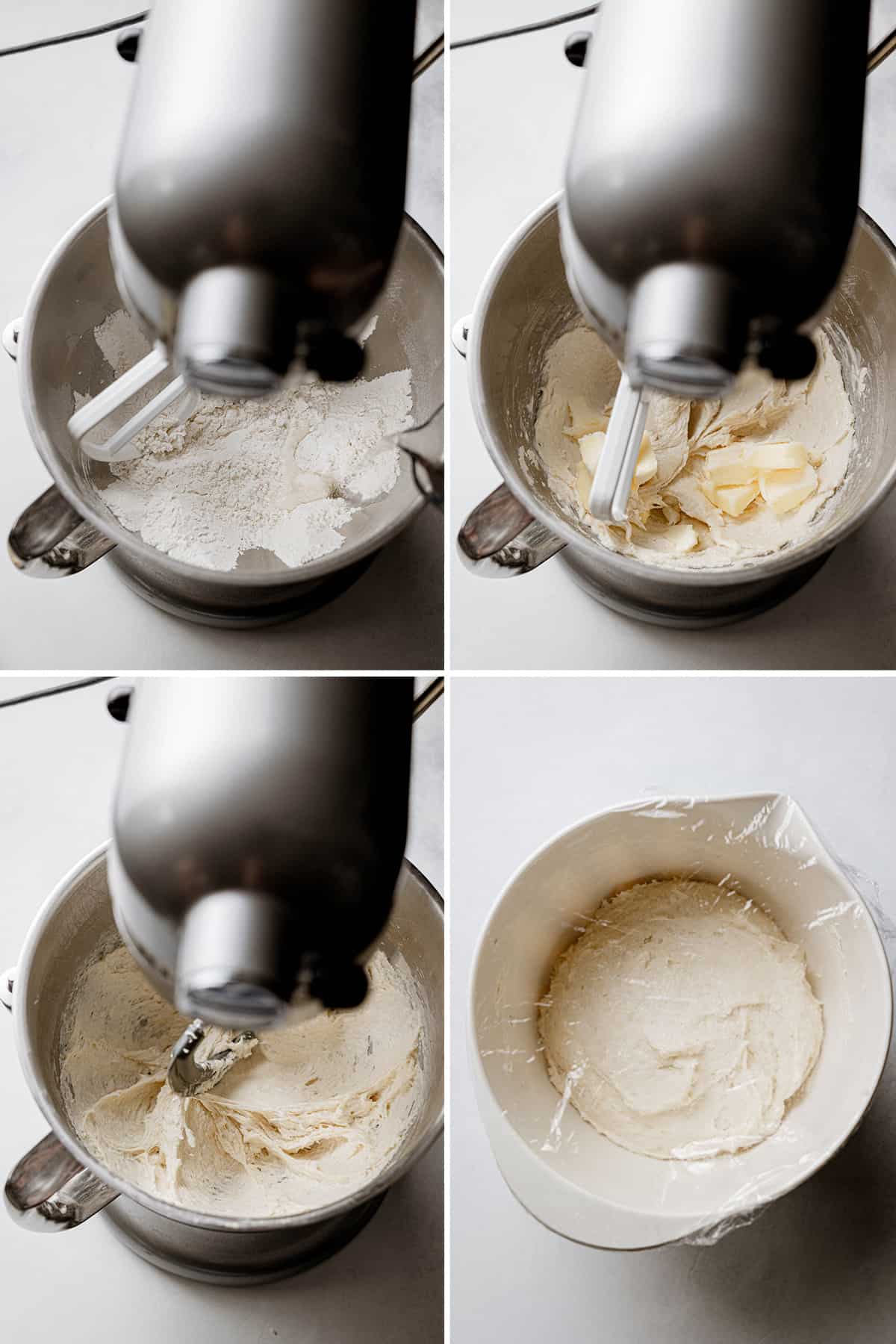
- Whisk together all of the dry ingredients. This includes the gluten-free flour, cornmeal, yeast, and kosher salt.
- Warm the water to 120-130°F. With the mixer on medium speed, blend the warm water into the flour mixture using the paddle attachment.
- Add the softened butter and continue to mix for an additional 2 minutes.
- Transfer the dough to a bowl and cover. Let the dough rise for about 1 hour or until doubled.
Let It Chill!
The dough is easiest to work with when cold. After rising, cover and refrigerate the dough for one hour or up to overnight.
How to Make the Sauce
The key to making the best Chicago deep dish lies in the chunky tomato sauce. It's surprisingly simple to make. It all starts with a can of crushed tomatoes.
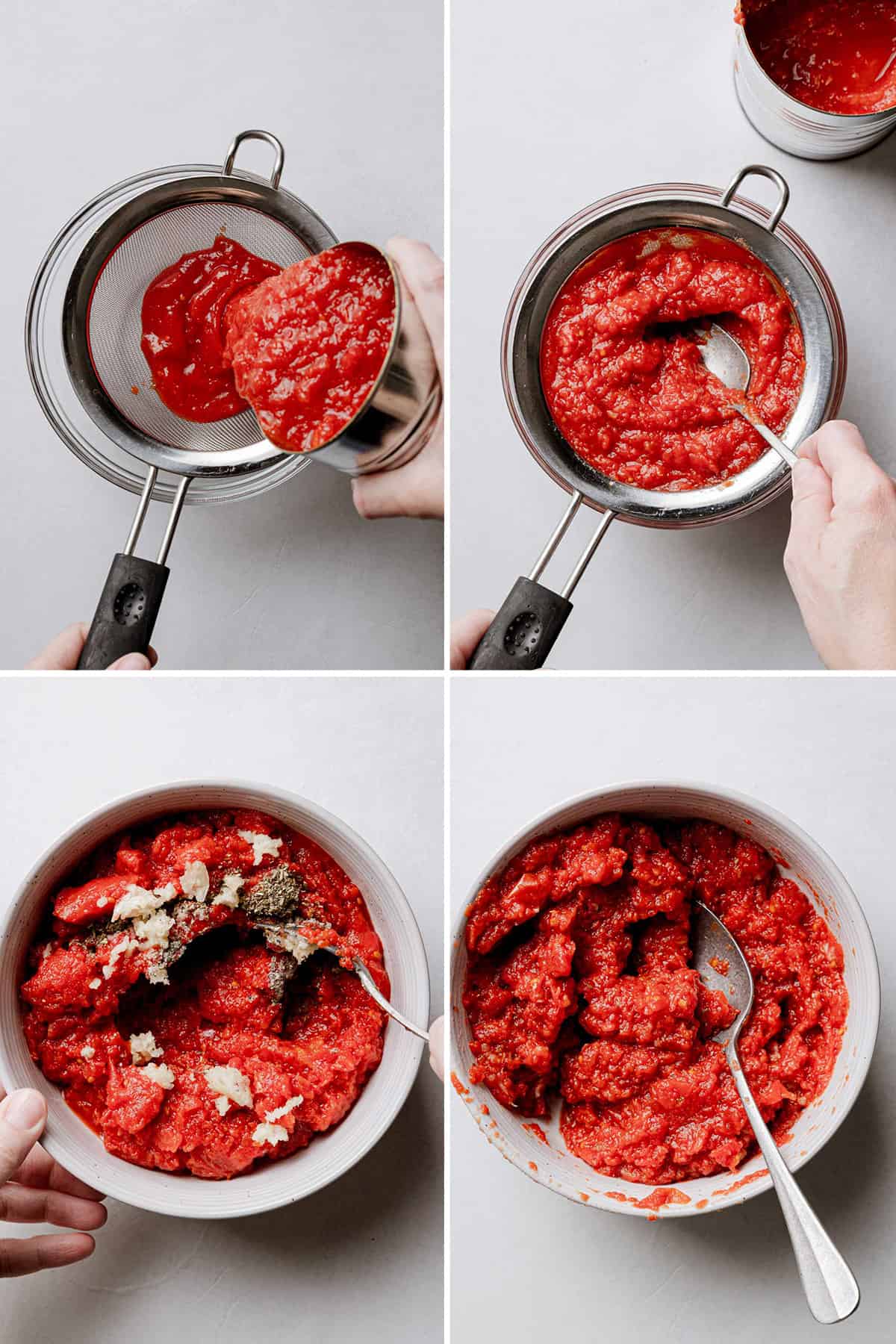
- Open the can of crust tomatoes and pour the contents into a fine mesh strainer.
- Allow gravity to do it's thing, or use the back of a spoon to coax the excess juice from the tomatoes.
- Place the strained tomatoes into a small bowl along with the minced garlic and Italian seasoning, salt, and pepper.
- Stir until combined.
Waste not!
Save the leftover, strained tomato juice for later use. Add it to soups, stews, homemade spaghetti sauce, or use it to make a Bloody Mary. It can be kept refrigerated for up to two weeks or frozen for even longer.
Assembling a Deep Dish Pizza
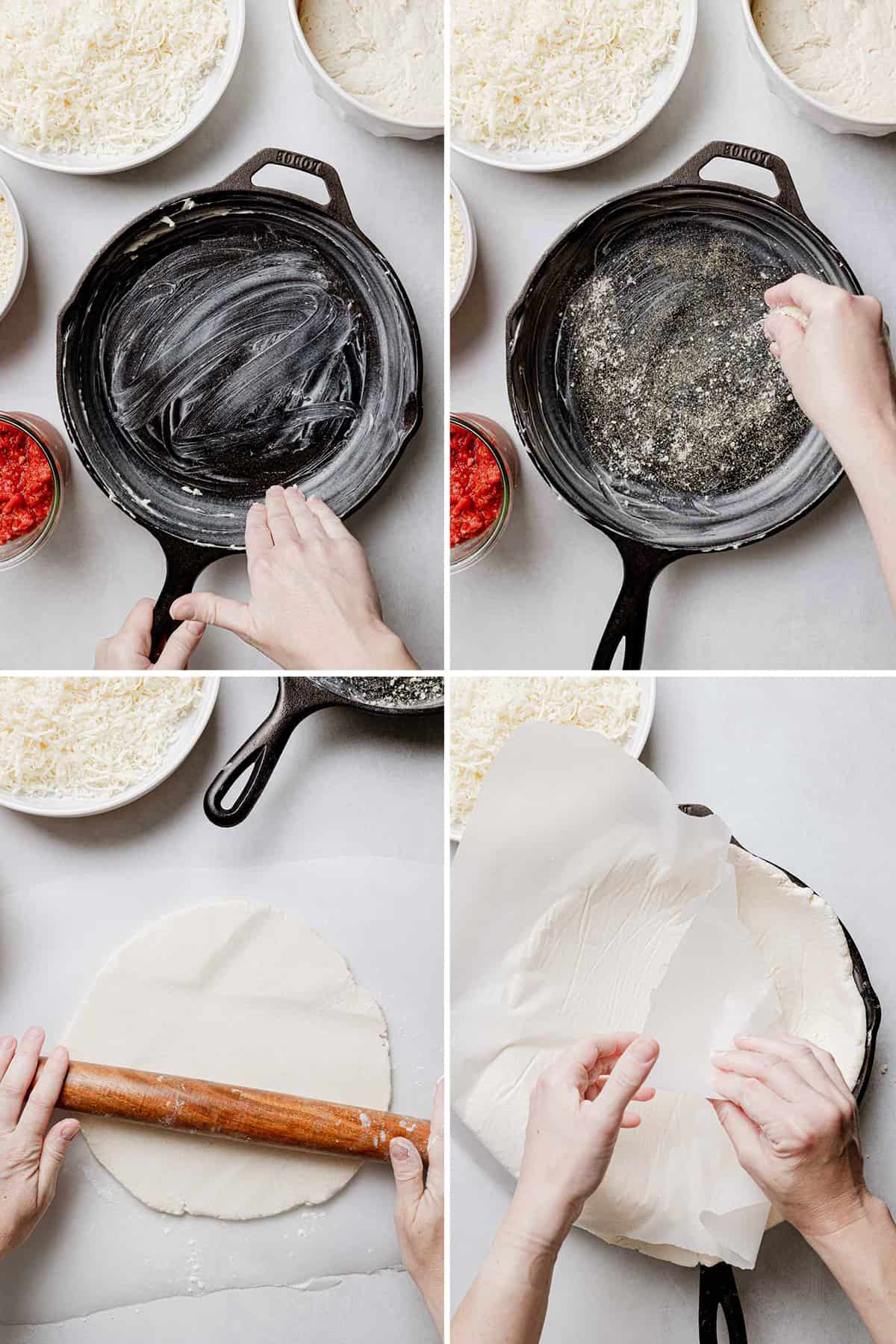
- Generously grease your pizza pan with butter.
- Sprinkle the bottom of the pan with cornmeal and grated parmesan cheese. This not only prevents the crust from sticking but adds flavor and crispness.
- Roll out the dough on a piece of parchment paper.
- Then, flip the dough into the prepared pan and peel the parchment off.
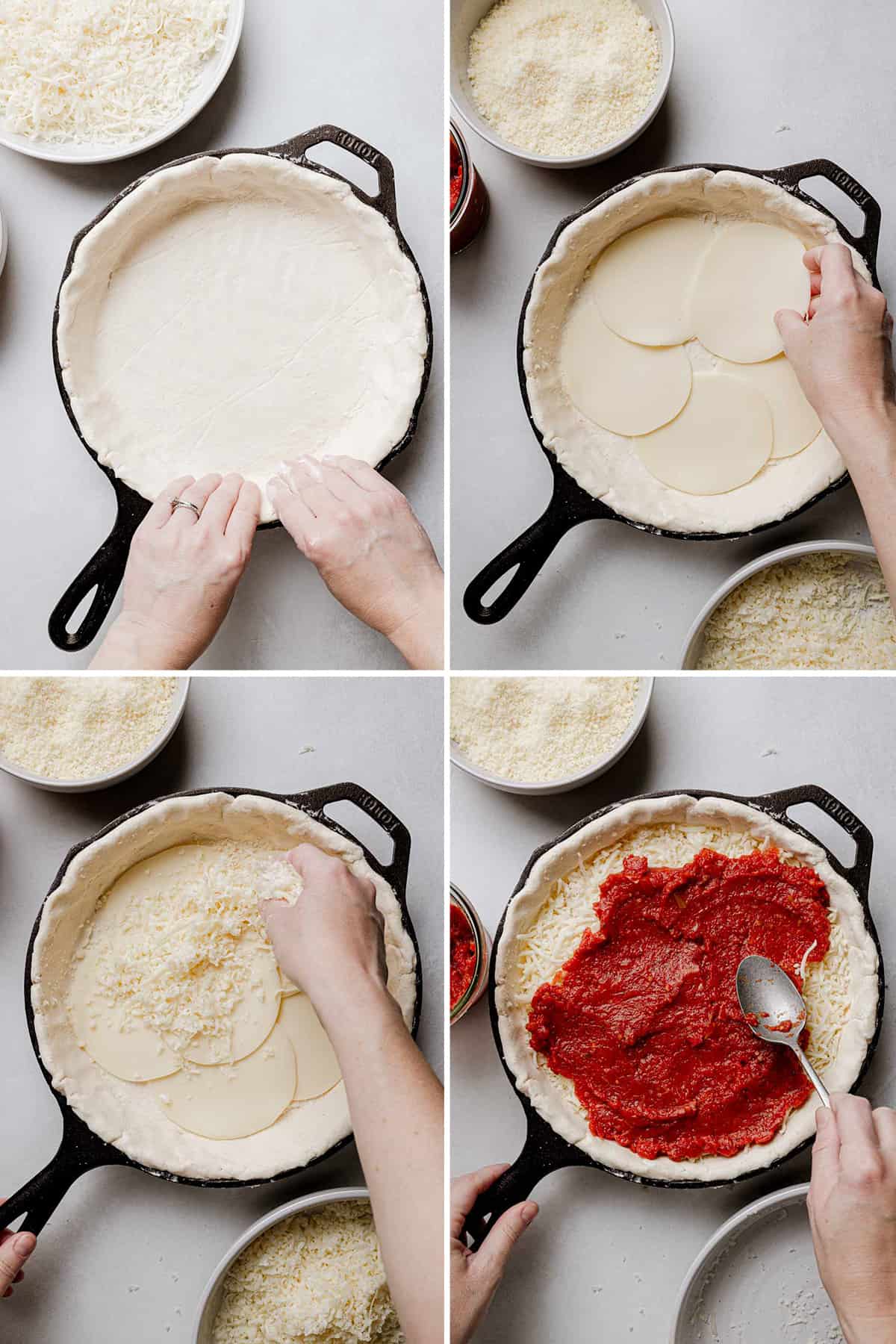
- Now, press the dough evenly in the bottom and up the sides of the pan, don't go past the top edge. If your dough does go past the edge, just fold it under and press against the sides to make it even.
- Place the sliced provolone cheese on top of the crust.
- Followed by the shredded mozzarella cheese.
- Lastly, dollop the tomato sauce on top of the cheese and spread it into an even layer with the back of a spoon.
- Sprinkle with grated parmesan before placing the pizza into a preheated oven to bake.
What about toppings?
Additional toppings, such as veggies, pepperoni, or sausage, go on top of the cheese before you add the pizza sauce. If you're using Italian sausage, simply dollop chunks of the sausage over the cheese, it does not need to be cooked first.
How to Tell When Deep Dish Pizza is Done
If you're struggling to know if your deep dish pizza is ready to pull from the oven, here are some signs to look for:
- Check the temp. The temperature in the center of the pizza should be 190°F or higher.
- Look and listen. You won't see tiny bubbles, but the pizza will still sound like it's sizzling. If you look closely at the center, it may look puffed or like it's slowly bubbling. This is a good sign the cheese is melting and your pizza is done.
- Check the crust. The edges of the crust may also start to pull away from the sides of the pan and the crust will appear lightly golden brown and crisp.
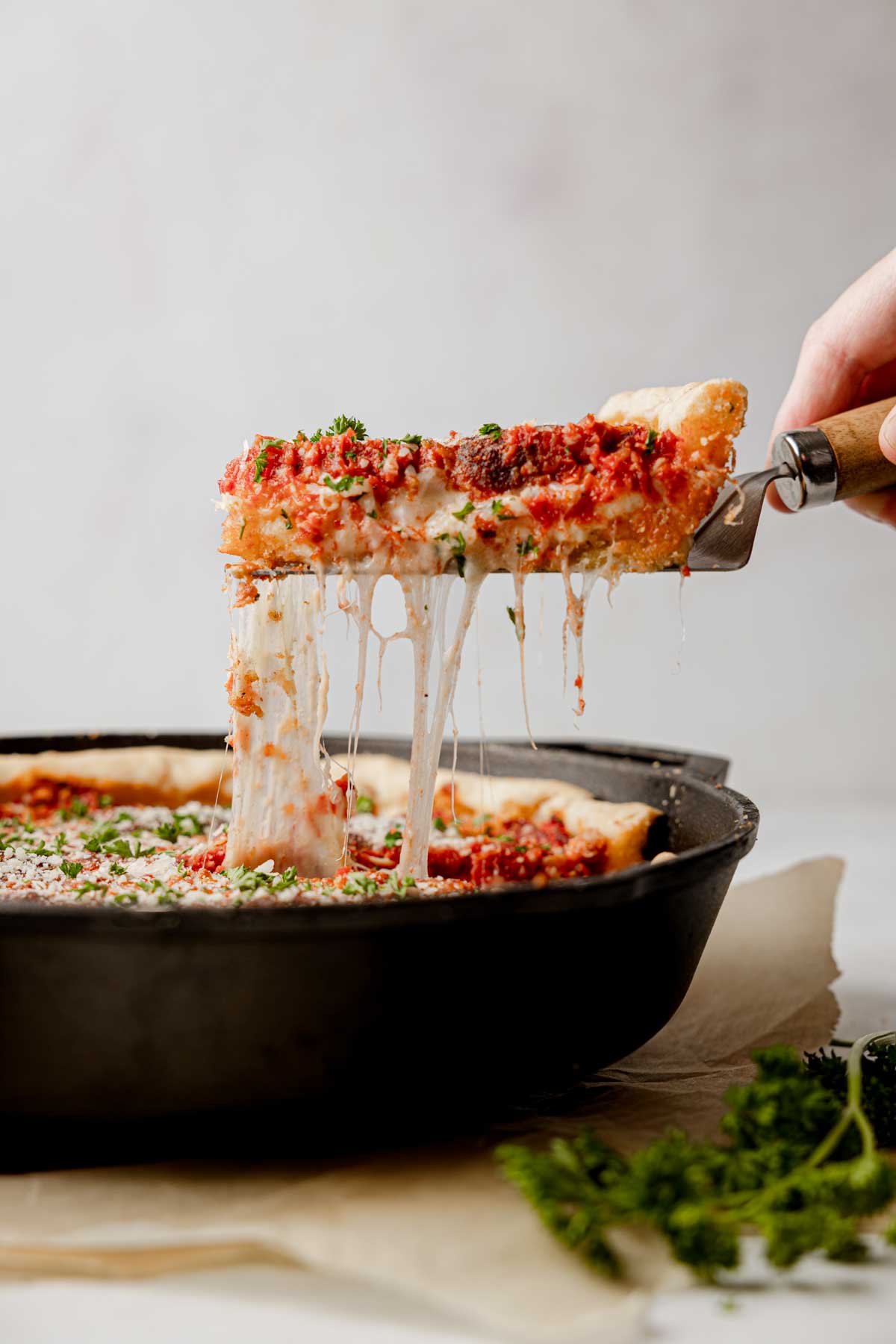
How to Serve Deep Dish Pizza
- Once you've removed the pizza from the oven, allow the pizza to rest for about 10 minutes.
- Use a sharp knife to slice the pizza right in the pan or remove the pizza to a cutting board to slice. A serrated knife can be helpful for getting through the crust.
- Slice the pizza into 8 slices. Each slice tends to be quite filling, so a little goes a long way!
Storage
Deep dish pizza is best enjoyed hot and fresh from the oven. Any leftovers can be refrigerated for several days or frozen for even longer.
The method of reheating depends on what is more important to you, immediate hunger satiation or maintaining crust integrity:
- If you're just hungry and want to heat it through as quickly as possible, reheat a slice in the microwave for 30 seconds to 1 minute.
- If you want the pizza to taste like it came fresh from the oven, reheat the pizza slices on a baking sheet in a 350°F oven or in the air fryer until warmed through.
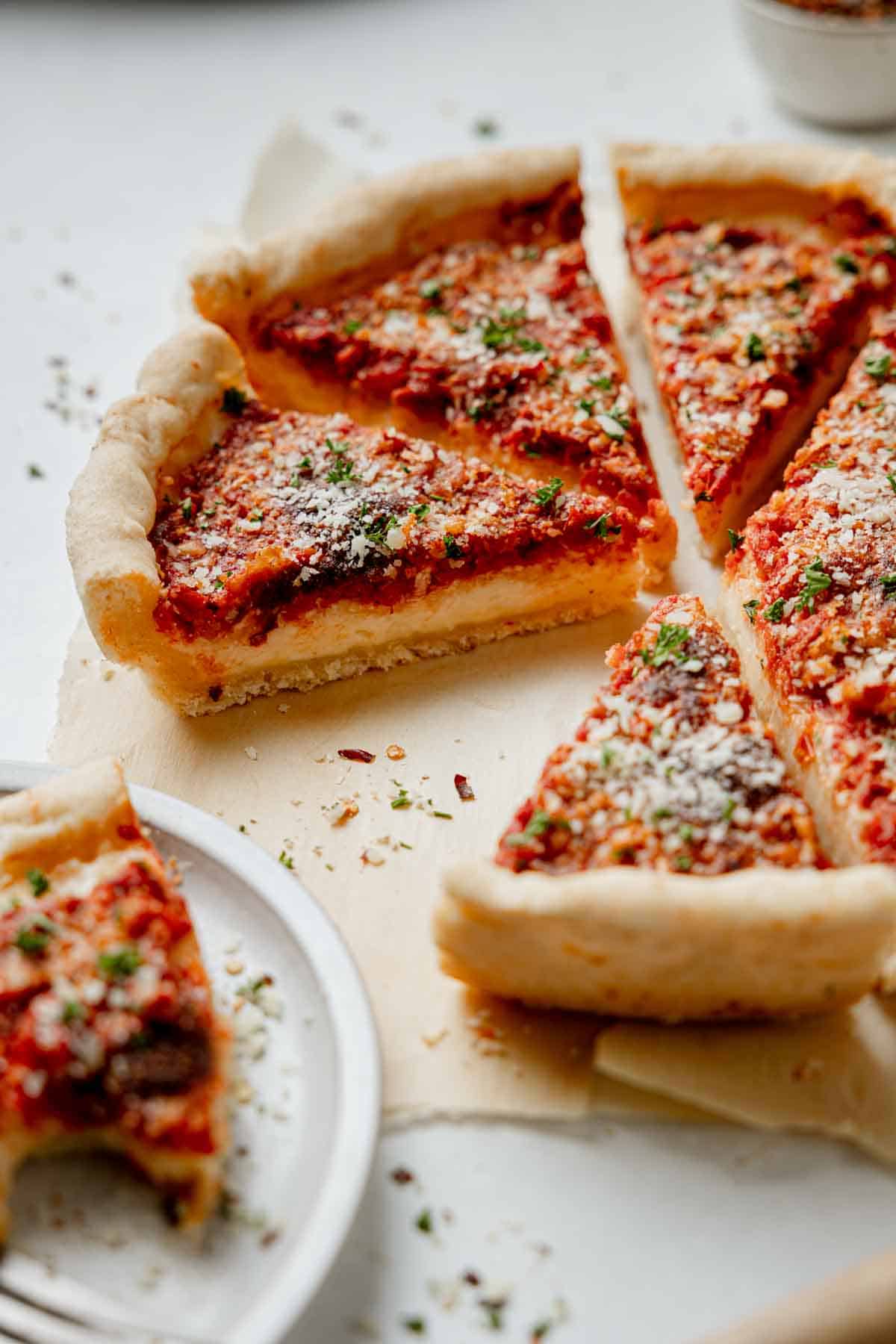
What to Serve with Deep Dish Pizza
While deep dish pizza can be a filling meal all by itself, it does pair well with a variety of side dishes. Here are some options to serve with your deep dish pizza:
- Salad: A fresh garden salad with crisp lettuce, tomatoes, cucumbers, and your favorite dressing provides a refreshing contrast.
- Antipasto platter: Create a spread of cured meats, cheeses, olives, pickles, and marinated vegetables for a delicious and satisfying appetizer or side.
- Roasted vegetables: Oven-roasted vegetables like broccoli, bell peppers, zucchini, or eggplant add a touch of freshness and color to your meal.
- Buffalo wings: For those who enjoy a little heat, serving some spicy buffalo wings alongside the pizza can add an extra kick to your meal.
More Recipe Tips
- Weigh your ingredients. For the most accurate results, use a digital kitchen scale to measure the dough ingredients.
- Plan ahead. The dough is easiest to work with when cold so plan to make the dough a few hours or even a day beforehand.
- Don't skip making the sauce. Store-bought pizza sauce or marinara sauce is just not the same. These typically don't have the right texture and have way too much moisture.
- Watch your baking times. Depending on the pan you use, your pizza may cook quicker or need longer to bake. A thin aluminum pan is going to bake faster than the cast-iron pan.
- Let it rest! When you remove the pizza from the oven, let it rest for about 10 minutes before slicing so the cheese doesn't ooze out everywhere.
FAQ
Caputo Fioreglut is hands down the best gluten-free flour blend for pizza. This versatile flour is designed to mimic the texture and performance of traditional wheat flour in gluten-free baking, especially yeast breads and pizzas.
Typically, pizza is not gluten-free unless advertised as such. Pizza dough is traditionally made with wheat flour.
Unless it is stated that the dough is specifically made with gluten-free flours, pizza dough contains gluten. Pizza dough is usually made with some form of wheat flour, like all-purpose flour or 00 flour.
Mozzarella cheese is inherently gluten-free. This includes the block forms and pre-shredded varieties.
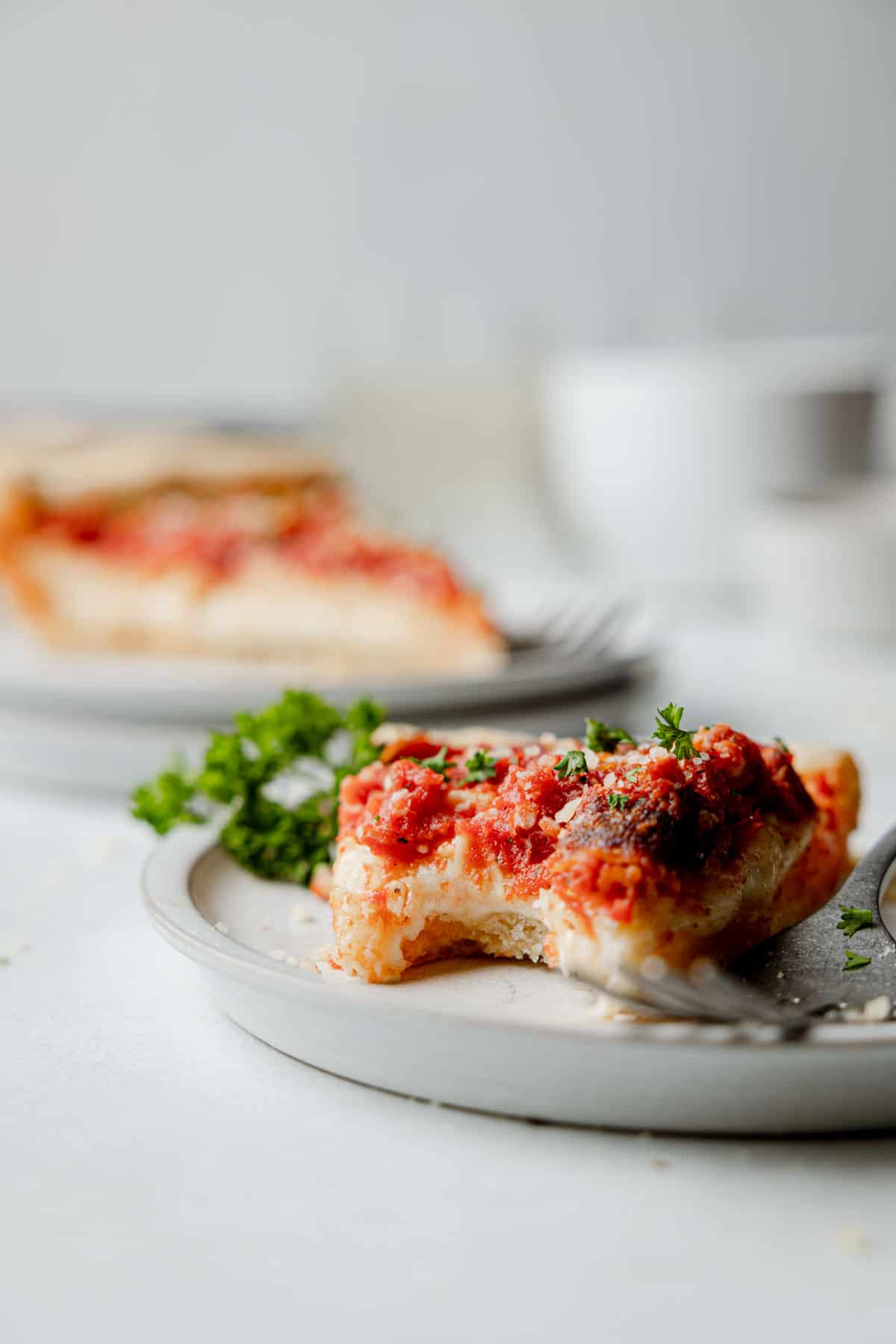
More Recipes You'll Love
Join My Newsletter!

Still Hungry? Subscribe Here!
Recipe

Gluten-Free Chicago Deep Dish Pizza
Equipment
Ingredients
Deep Dish Pizza Dough
- 225 g Caputo Fioreglut gluten-free flour
- 25 g cornmeal
- 8 g kosher salt
- 5 g instant yeast, Rapid Rise or Bread Machine
- 190 g water, warmed to 120-130°F
- 113 g butter, softened
Tomato Sauce
- 28 ounces crushed tomatoes
- 2 cloves garlic , minced
- 1 teaspoon Italian seasoning
- ¼ teaspoon kosher salt
- ⅛ teaspoon black pepper
Toppings
- 4 ounces provolone cheese, sliced or shredded
- 12 ounces mozzarella cheese, shredded
- 2 ounces grated parmesan cheese, divided
- desired toppings, such as Italian sausage, pepperoni, or sliced onions and green bell pepper
Instructions
Make the Dough:
- In a mixer bowl, whisk together the Caputo Fioreglut gluten-free flour, cornmeal, kosher salt, and instant yeast.
- Gradually add the warmed water (120-130°F) to the dry ingredients while mixing on medium speed. Blend until combined.
- Add the softened butter to the dough and continue mixing until fully incorporated and the dough is smooth, about 2 minutes, scraping the sides as needed.
- Transfer the dough to a greased bowl, cover with a kitchen towel or plastic wrap, and let it rise for 1 hour.
- Optionally, refrigerate the dough, keeping it covered, for at least 1 hour or overnight (this makes the dough easier to work with).
Make the Tomato Sauce:
- Place a fine mesh strainer over a small bowl and pour the crushed tomatoes into it, allowing excess moisture to drain. Gently press the tomatoes to remove any excess juice.
- In a separate bowl, mix the strained tomatoes with minced garlic, Italian seasoning, kosher salt, and black pepper. Set aside.
Assembling the Pizza:
- Preheat the oven to 425°F.
- Generously grease a cast-iron or deep-dish pizza pan with softened butter. Sprinkle with a light dusting of cornmeal and some of the parmesan cheese.
- Roll out the pizza dough on a piece of parchment paper, making it about 2 inches wider than your pizza pan.
- Transfer the dough to the pan and press it evenly across the bottom and up the sides. If the dough extends beyond the top edge of the pan, gently fold it under and press to align with the top edge.
- Layer provolone cheese slices on the dough, followed by shredded mozzarella cheese. Sprinkle half of the remaining grated parmesan cheese over the mozzarella.
- Add desired toppings, then dollop and spread the tomato sauce evenly over the cheese and toppings. Sprinkle with parmesan cheese.
- Bake the pizza in the preheated oven for 40-60 minutes, or until the crust is golden brown and the center is hot and puffed. The internal temperature should reach 190°F or higher.
- Remove the pizza from the oven and, if desired, sprinkle with additional parmesan cheese. Allow it to cool for about 10 minutes before slicing and serving.
Notes
- Weigh your ingredients. For the most accurate results, use a digital kitchen scale to measure the dough ingredients. Click the US/Cups button at the top of the list of ingredients for alternate measurements.
- Plan ahead. The dough is easiest to work with when cold so plan to make the dough a few hours or even a day beforehand.
- Watch your baking times. Depending on the pan you use, your pizza may cook quicker or need longer to bake. A thin aluminum pan is going to bake faster than the cast-iron pan.
- Caputo Fioreglut is gluten-free but does contain gluten-free wheat starch and is not suitable for a wheat allergy.
Nutrition
* Nutritional information is provided as a courtesy and should be used as an estimate only. See the nutrition policy for more information.






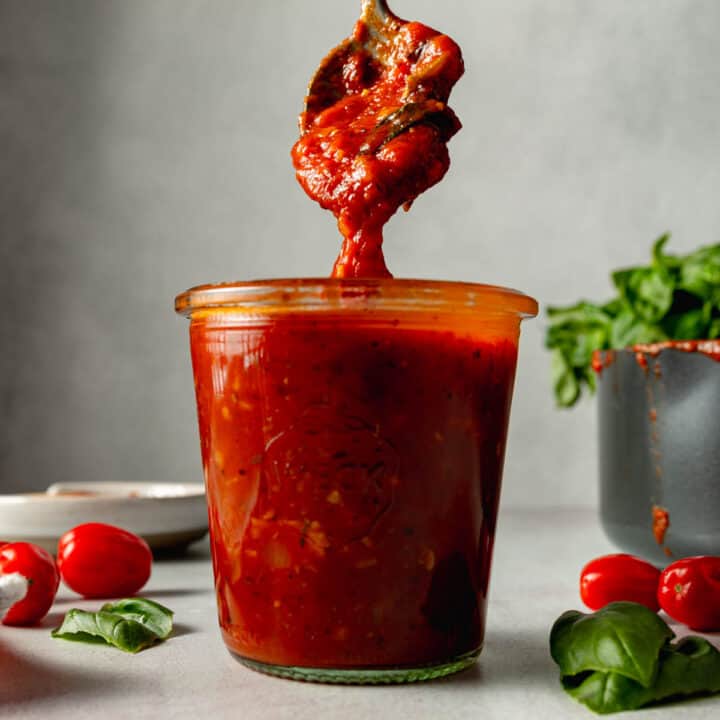
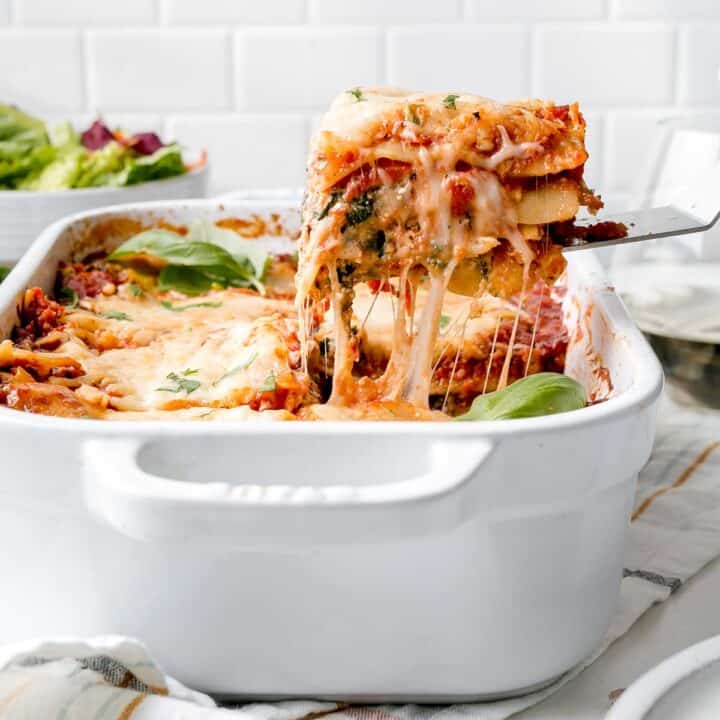

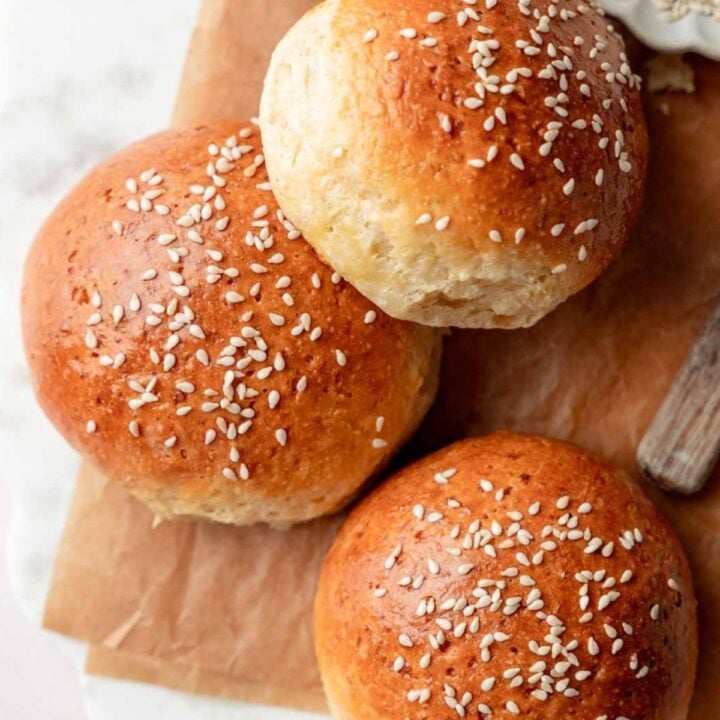
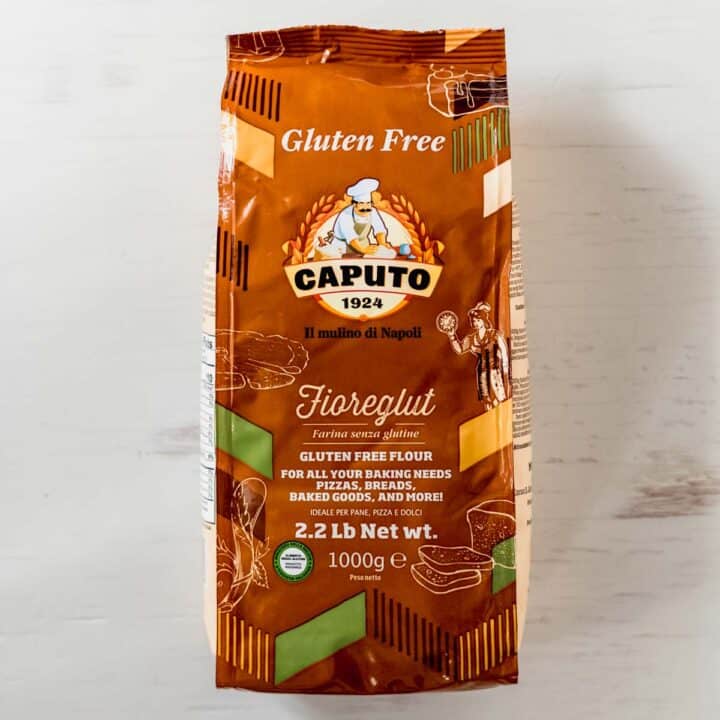
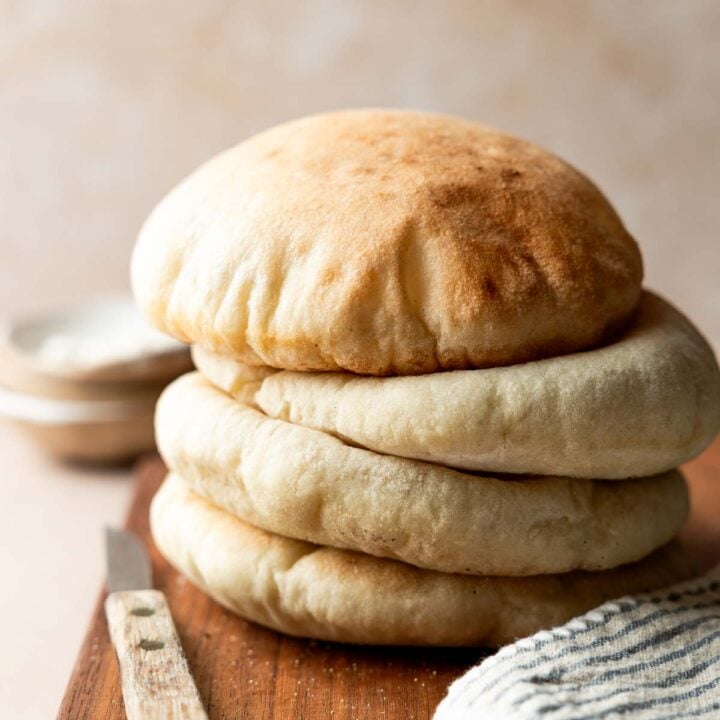

Karen Schulte says
Amazing crust for GF. Stickier than regular pizza dough but bakes up fine. I made mine in an iron skillet.
Becca says
My flour isn’t balling up when I add the water. Is this okay or should I add more water?
Katie Olesen says
Yes, maybe your conditions are a little dry. You can add just a tiny amount of water at a time until it comes together.